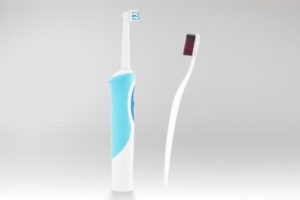Whitening products
Toothpaste that contains hydrogen peroxide can whiten teeth over time. Whitening strips apply a thin layer of a peroxide-based gel that also has a whitening effect over time. Some mouthwashes also include hydrogen peroxide; a 2013 study found that using them for 12 weeks achieved results similar to two weeks of using a whitening gel. While the American Dental Association says all these products are safe if used properly, speak with your dentist before starting a whitening program at home. Baking soda also has been proven effective in removing stains.Manual toothbrush
Three months is the maximum life of a toothbrush, so if yours predates the Fourth of July, it’s replacement time. The most important aspect of the perfect toothbrush: soft or extra soft bristles, says Jessica Hilburg, associate dean at the New York University College of Dentistry. “Medium and hard bristles can be too abrasive and hurt the gums, and won’t remove plaque as well as a softer bristle.” And choose a brush with multilevel or angled bristles. A review found those shapes substantially outperformed flat-trimmed bristles for overall plaque removal.Electric toothbrush
Score one for technology: A review of clinical studies by the Cochrane Oral Health Group shows that over the long haul, electric toothbrushes reduce plaque 21 percent more effectively than manual brushes. Look for a powered brush with a round, oscillating head. One study found that it produced significantly greater reductions in both gingivitis and plaque compared with one with a vibrating head. And look for a brush that features both a two-minute timer and a pressure indicator.Mouthwash
If you’re looking for an antimicrobial mouthwash to help counter bad breath, look for the active ingredients chlorhexidine, chlorine dioxide and cetylpyridinium chloride, and essential oils like eucalyptol, menthol, thymol and methyl salicylate. To fight plaque and gingivitis, keep an eye out for the active ingredients cetylpyridinium chloride and chlorhexidine. Added fluoride will give you extra ammunition for fighting cavities.
Toothpaste
If you’re dealing with gingivitis and bleeding gums, look for a toothpaste with stannous fluoride, says Tiffany Delaney, a registered dental hygienist in New York. If sensitive teeth are your problem, studies have shown that incorporating toothpaste or mouthwash that contains potassium nitrate into your routine can significantly decrease sensitivity. Delaney recommends against trendy charcoal toothpastes, which are too abrasive, and “natural” toothpastes that don’t remove plaque as effectively.Floss
In addition to adding more plastic into the environment, those little floss sticks don’t wrap around teeth as well as the traditional floss you roll around your finger. “The best type of floss to use is a thicker, more rigid floss rather than a slick, thin floss. Thinner floss may be easier to slip between teeth, but it does not grab hold of the sticky plaque and food debris like a thicker floss will,” says Hilburg. While she recommends actual floss over water flossers, the latter have plenty of fans. The American Dental Hygienists Association recommends a unit that delivers water pressure of 50 to 90 pounds per square inch (psi), a level that both healthy and inflamed gum tissue can withstand without damage.Perfect brushing reminders
- For inside surfaces of front teeth: Hold your brush vertically and use up-and-down strokes.
- For all other teeth surfaces: Place your brush at a 45-degree angle to the gums. Brush back and forth in short, gentle strokes.
- A good brushing takes at least two minutes; do it twice a day. Brush your tongue each time as well to help keep bacteria at bay.


